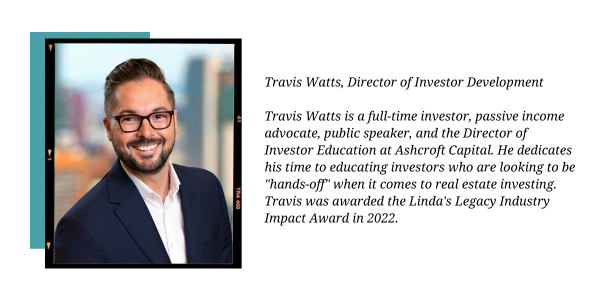December 27, 2023
By: Travis Watts, Director of Investor Development
2023 Multifamily Acquisitions Snapshot
The multifamily real estate market has remained strong over the past year, with rent growth and high occupancy rates. The U.S. has also faced increasing expenses, higher insurance costs, property taxes, and wages, all of which can be attributed to inflation. As a result, we’ve evolved our multifamily acquisition strategies to benefit our investors.
Why is deal research important?
Thorough deal research requires a multi-step analysis to ensure a viable and profitable real estate investment outcome. Ashcroft Capital’s comprehensive guide to deal research provides a thorough analysis that factors in market research, expenses, investment goals, among other vital aspects of the due diligence process.
How do we choose deals?
Real estate investing can be incredibly lucrative, but comes with risk. Diligent research is essential for investing success. At Ashcroft Capital, we conduct thorough due diligence when identifying investment opportunities.
Several factors determine a profitable and successful multifamily acquisitions strategy:
- Cash flow: Positive cash flow can promote steady income and allows investors the opportunity to invest their capital or create multiple passive income streams.
- Leverage: Leveraging properties with debt (a mortgage) allows investors to maximize their returns and increase profitability. Borrowing funds or using alternative sources of capital to finance the investment is an essential factor.
- Equity: As a property appreciates after renovations, investors’ equity grows, which provides opportunities for refinancing or selling at a higher price.
- Appreciation: Additionally, market trends, location advantages, and potential growth factors can drive property value appreciation resulting in further profit potential when the property sells.
- Risk: Market volatility, tenant turnover, or repairs and maintenance costs, are balanced against potential returns to make the most informed investment decisions.
What changed with 2023 multifamily acquisitions?
2022 was a strong year for the multifamily real estate market. 2022 had record-high occupancy and rental growth. The high apartment demand, combined with inflation, helped justify rental rate increases in addition to value-add business plans.
As we moved into 2023, the multifamily real estate market faced more challenges. These challenges required acquisitions strategies to evolve. Some of these challenges include:
- Interest rates: Rates have remained high, without concrete insight into when they will come down. Higher interest rates result in higher financing costs, impacting multifamily real estate valuations. The continued uncertainty with what the Fed will do with interest rates halted activity in the multifamily acquisitions market Additionally, it has halted lenders. In turn, this left many sellers unclear on market pricing.
- Inflation and potential recession: In Q4 of 2023, we continue to see higher interest rates due to the Feds’ efforts to lower inflation. Despite the high interest rates, the multifamily real estate market has historically been a top real estate investment during recessions because of high demand and the need for affordable housing solutions during tough economic times.
- Difficulty refinancing: Refinancing has also become more complex because of the higher interest rates. Refinancing in today’s environment likely means obtaining a higher interest rate on a loan, which has caused property owners to wait to refinance.
How have Ashcroft’s multifamily acquisitions strategies evolved?
At Ashcroft Capital, we continue to evolve our real estate investing process to adjust with the market. The goal is create a healthy risk-adjusted return. We identify suitable properties that have the potential for further improvement. Factors that go into selecting the right property include:
- Location strength: We research hundreds of markets, focusing on both emerging locations and return potential opportunities. We prioritize areas demonstrating economic growth, diverse employment sectors, and favorable demographic trends. We also seek value-add and core-plus properties in strong submarkets with high occupancy rates.
- Due diligence: We have a rigorous 144 step due diligence process to evaluate multifamily real estate deals and ensure each property fits within our investment criteria.
- Relationships: We have spent years developing relationships with brokers and sellers, and this aids in the process of evaluating potential deals. Our strong network provides valuable insights and off-market opportunities.
“If the right deal comes along and we have the right relationship with the seller, and it’s in the right market we will absolutely pursue those,” says Scott Lebenhart, CIO at Ashcroft Capital.
“We’re doing a tremendous amount of research on potential opportunities. We’re trying to find the right deals, meaning we’re looking at very specific submarkets, specific vintages, specific demand drivers, specific average household incomes.”
We were highly selective with the deals that presented themselves this year. If the property wasn’t in one of our desired markets or submarkets, or if the asset doesn’t adhere to Ashcroft’s quality standards, we won’t spend our time on it.
Additionally, if the property has an unreasonable price, that tells us that the seller isn’t motivated to sell. We choose to spend our resources on deals that we know will be a success. If a sale price is unrealistic given current market conditions, we will strategically decide to wait until the seller has a more realistic offer price.
In Conclusion – Ashcroft Capital’s Evolving Strategies
Our multifamily acquisitions strategies continue to evolve as we navigate through the current economic landscape. We’ve applied these updated strategies to choose our most recent acquisitions, Midtown 501, Elliot Cocoplum, and Halston Lakeside. We adjusted our acquisitions strategy to leverage strong markets, established industry relationships, and acquired fixed-rate loans for our recent acquisitions. These factors, in turn, provide our investors long-term capital preservation and growth potential in an ever-changing environment.





